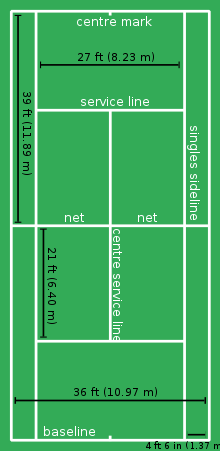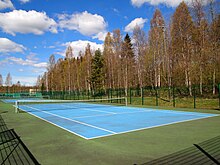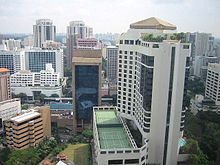
Tennis is a racket sport that is played either individually against a single opponent (singles) or between two teams of two players each (doubles). Each player uses a tennis racket that is strung with cord to strike a hollow rubber ball covered with felt over or around a net and into the opponent's court. The object of the game is to manoeuvre the ball in such a way that the opponent is not able to play a valid return. The player who is unable to return the ball validly will not gain a point, while the opposite player will.
The Grand Slam in tennis is the achievement of winning all four major championships in one discipline in a calendar year. In doubles, a Grand Slam may be achieved as a team or as an individual with different partners. Winning all four major championships consecutively but not within the same calendar year is referred to as a "non-calendar-year Grand Slam", while winning the four majors at any point during the course of a career is known as a "Career Grand Slam".

The ATP Finals is the season-ending championship of the ATP Tour. It is the most significant tennis event in the men's annual calendar after the four majors, as it features the top eight singles players and top eight doubles teams based on their results throughout the season. The eighth spot is reserved, if needed, for a player or team who won a major in the current year and is ranked from ninth to twentieth.

A hardcourt is a surface or floor on which a sport is played, most usually in reference to tennis courts. It is typically made of rigid materials such as asphalt or concrete, and covered with acrylic resins to seal the surface and mark the playing lines, while providing some cushioning. Historically, hardwood surfaces were also in use in indoor settings, similar to an indoor basketball court, but these surfaces are rare now.
Serve-and-volley is a style of play in tennis where the player (volleyer) serving moves quickly towards the net after hitting a serve, to attempt to hit a volley afterwards. In the serve-and-volley playstyle, the server attempts to hit a volley, as opposed to the baseline game, where the server stays back following the serve and attempts to hit a groundstroke. As a returner/receiver (volleyer) of a serve, the player may also attempt to hit a half-volley, instead of waiting longer after the ball has bounced to hit a usual groundstroke. The serve-and-volley style of play has diminished in recent years with advances in racquet and string technologies which allow players to generate a great amount of top spin on groundstrokes and passing shots. The slowing of court surfaces and deflation of balls, promoting longer rallies for the enjoyment of spectators, has also devalued the serve-and-volley style.
A point in tennis is the smallest subdivision of the match. A point can consist of a double fault by the server, in which case the point is automatically won by the receiver. In all other cases, a point begins when a legal serve is hit by the server to the receiver on the opposite side of the court, and continues until one side fails to legally return the ball to the opposite side. Whichever side fails to do so loses the point and their opponent wins it.
This page is a glossary of tennis terminology.
Players use different strategies while playing tennis to enhance their own strengths and exploit their opponent's weaknesses in order to gain the advantage and win more points.

A clay court is one of the types of tennis court on which the sport of tennis is played. Clay courts are built on a foundation of crushed stone, brick, shale, and other aggregate, with a thin layer of fine clay particles on top. Clay courts are more common in Continental Europe and Latin America than in North America, Asia-Pacific or Britain. The only Grand Slam tournament that uses clay courts is the French Open.
Traditionally, tennis is played between two people in a singles match, or two pairs in a doubles match. Tennis can also be played on different courts, including grass courts, clay courts, hard courts, and artificial grass courts.
The 1975 US Open was a tennis tournament that took place on the outdoor clay courts at the West Side Tennis Club in Forest Hills, Queens, in New York City, United States. The tournament ran from 27 August until 7 September. It was the 95th staging of the US Open, and the fourth Grand Slam tennis event of 1975. During the final three years at the Forest Hills location, 1975-1977, the US Open was played on a green-colored Har-Tru clay surface, a surface slightly harder and faster than red clay. The switch came after player complaints about the poor state and uneven ball bounce on the grass courts in Forest Hills. The tie-break scoring system changed in this championship. Previously a sudden death point was played at 4–4 with the winner the first to 5 points. It changed to the 13 point tie-break first to 7 points or the first player to win by two clear points if the scores reached 6–6.
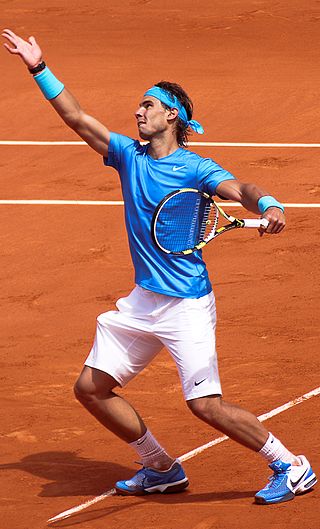
The tennis rivalry between Roger Federer and Rafael Nadal is considered one of the greatest in the history of the sport. Federer and Nadal played each other 40 times, with Nadal leading 24–16 overall, including 14–10 in finals.
The following outline is provided as an overview of and topical guide to tennis.
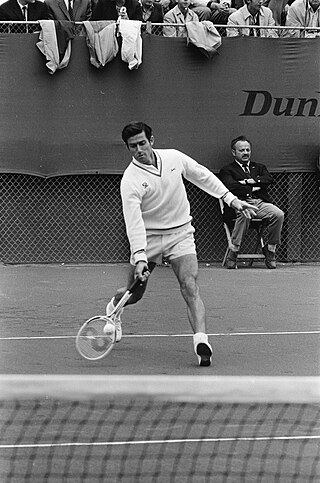
The Laver–Rosewall rivalry was a tennis rivalry in the 1960s and 1970s between Australian players Rod Laver and Ken Rosewall, widely regarded as two of the greatest tennis players of all time. In 1956 both players toured in the amateur circuit but never faced each other. Rosewall turned professional in January 1957 and the two did not meet until January 1963 when Laver turned pro. They played many times until 1977 when both semi-retired from the main tour.
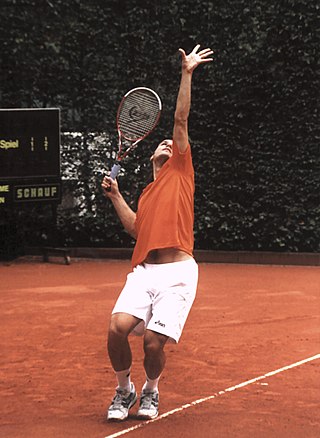
A serve in tennis is a shot to start a point. A player will hit the ball with a racquet so it will fall into the diagonally opposite service box without being stopped by the net. Normally players begin a serve by tossing the ball into the air and hitting it. The ball can only touch the net on a return and will be considered good if it falls on the opposite side. If the ball contacts the net on the serve but then proceeds to the proper service box, it is called a let; this is not a legal serve in the major tours although it is also not a fault. Players normally serve overhead; however serving underhand is allowed. The serve is the only shot a player can take their time to set up instead of having to react to an opponent's shot; however, as of 2012, there is a 25-second limit to be allowed between points.
The Open Era is the current era of professional tennis. It began in 1968 when the Grand Slam tournaments allowed professional players to compete with amateurs, ending the division that had persisted since the dawn of the sport in the 19th century. The first open tournament was the 1968 British Hard Court Championships held in April, followed by the inaugural open Grand Slam tournament, the 1968 French Open, a month later. Unless otherwise sourced, all records are based on data from the Association of Tennis Professionals (ATP), the International Tennis Federation (ITF), and the official websites of the four Grand Slam tournaments. All rankings-related records are based on ATP rankings, which began in 1973. The names of active players appear in boldface.
This article covers the period from 1877 to present. Before the beginning of the Open Era in April 1968, only amateurs were allowed to compete in established tennis tournaments, including the four Grand Slam tournaments. Wimbledon, the oldest of the majors, was founded in 1877, followed by the US Open in 1881, the French Open in 1891 and the Australian Open in 1905. Beginning in 1905 and continuing to the present day, all four majors have been played yearly, with the exception of during the two World Wars, 1986 for the Australian Open, and 2020 for Wimbledon. The Australian Open is the first major of the year (January), followed by the French Open (May–June), Wimbledon (June–July) and the US Open (August–September). There was no prize money and players were compensated for travel expenses only. A player who wins all four majors, in singles or as part of a doubles team, in the same calendar year is said to have achieved a "Grand Slam". If the player wins all four consecutively, but not in the same calendar year, it is called a "Non-Calendar Year Grand Slam". Winning all four at some point in a career, even if not consecutively, is referred to as a "Career Grand Slam". Winning the four majors and a gold medal in tennis at the Summer Olympics in the same calendar year has been called a "Golden Slam" since 1988. Winning all four majors plus an Olympic gold at some point in a career, even if not consecutively, is referred to as a "Career Golden Slam". Winning the year-end championship while also having won a Golden Slam is referred to as a "Super Slam". Winning all four majors, an Olympic gold, and the year-end championships at some point in a career, even if not consecutively, is referred to as a "Career Super Slam". Winning the four majors in all three disciplines a player is eligible for–singles, doubles and mixed doubles–is considered winning a "boxed set" of Grand Slam titles.

A carpet court is a type of tennis court. The International Tennis Federation describes the surface as a "textile or polymeric material supplied in rolls or sheets of finished product". It is one of the fastest court types, second only to grass courts. The use of carpet courts in ATP Tour competitions ended in 2009. In women's tennis, no WTA Tour tournaments have used carpet courts since the last edition of the Tournoi de Québec in 2018. ATP Challenger and ITF circuit level tournaments with carpet courts continue to exist up to the present (2024).

This was a tennis rivalry played between French player Jean Borotra and the French player Henri Cochet, which in their respective careers the met 16 times from 1922 until 1949.

